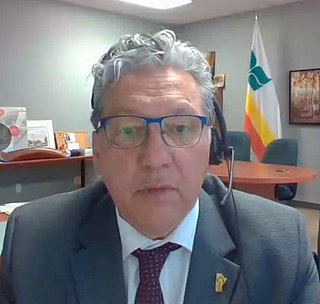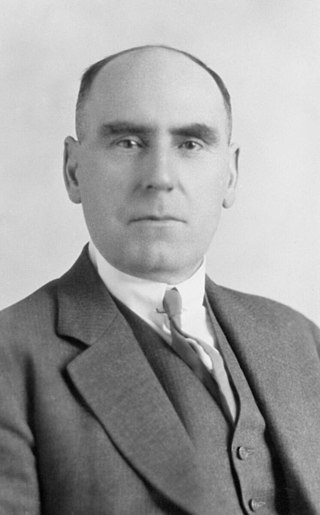Related Research Articles
Ethel Dorothy Blondin-Andrew is a Canadian politician, educator, and public servant. She became the first Indigenous woman to be elected to the Parliament of Canada in 1988 when she became a member of Parliament for the district of Western Arctic in the Northwest Territories. She is also the first Indigenous woman to be a Canadian Cabinet Minister.

Daniel Vandal is a Canadian politician. He represented St. Boniface on the Winnipeg City Council from 1995 to 2004 and from 2006 to 2014, and ran unsuccessfully for mayor of Winnipeg in 2004, coming in second to Sam Katz. He briefly served as acting mayor of Winnipeg following Glen Murray's resignation. On October 19, 2015, he was elected as the member of Parliament for Saint Boniface—Saint Vital in the House of Commons of Canada. He is a member of the Liberal Party of Canada and served as the Federal Minister of Northern Affairs in Justin Trudeau's cabinet. On October 26, 2021, he was also named Minister responsible for the Canadian Northern Economic Development Agency and Minister responsible for the Prairies Economic Development Agency of Canada, positions he held until 2024.

The Northwest Territories Legislative Assembly, or Legislative Council of the Northwest Territories, is the legislature and the seat of government of Northwest Territories in Canada. It is a unicameral elected body that creates and amends law in the Northwest Territories. Permanently located in Yellowknife since 1993, the assembly was founded in 1870 and became active in 1872 with the first appointments from the Government of Canada.
Canada holds elections for legislatures or governments in several jurisdictions: for the federal (national) government, provincial and territorial governments, and municipal governments. Elections are also held for self-governing First Nations and for many other public and private organizations including corporations and trade unions. Municipal elections can also be held for both upper-tier and lower-tier governments.

Alexander Morris was a Canadian politician. He served in the cabinet of Prime Minister John A. Macdonald (1869–1872), and was the second Lieutenant Governor of Manitoba (1872–1877). He also served as the founder and first Lieutenant Governor of the District of Keewatin.
Beverly Faye Desjarlais was a Canadian politician. She represented the Manitoba electoral district of Churchill in the House of Commons of Canada from 1997 to 2006, initially as a New Democrat and later as an Independent after losing her party's nomination in late 2005. She had lost the confidence of the NDP after she voted against the Civil Marriage Act, legalizing same-sex marriage in Canada. She later worked as a departmental aide to Conservative Veterans Affairs Minister Greg Thompson.

The District of Keewatin was a territory of Canada and later an administrative district of the Northwest Territories. It was created in 1876 by the Keewatin Act, and originally it covered a large area west of Hudson Bay. In 1905, it became a part of the Northwest Territories and in 1912, its southern parts were adjoined to the provinces of Manitoba and Ontario, leaving the remainder, now called the Keewatin Region, with a population of a few thousand people. On April 1, 1999, the Keewatin Region was formally dissolved, as Nunavut was created from eastern parts of the Northwest Territories, including all of Keewatin.

The 1902 North-West Territories general election, occurred on 21 May 1902 and was the fifth general election in the history of the North-West Territories, Canada. It was held to elect 35 Members of the Legislative Assembly of the North-West Territories.
The 1888 North-West Territories general election elected members of the 2nd Legislative Council of the North-West Territories. The 2nd Legislative Council of the North-West Territories replaced the 1st Council of the North-West Territories. The 2nd Legislative Council of the North-West Territories was replaced by the 1st North-West Assembly in 1891 when the quota of elected members was reached.

The history of Northwest Territories capital cities begins with the purchase of the Territories by Canada from the Hudson's Bay Company in 1869, and includes a varied and often difficult evolution. Northwest Territories is unique amongst the other provinces and territories of Canada in that it has had seven capital cities in its history. The territory has changed the seat of government for numerous reasons, including civil conflict, development of infrastructure, and a history of significant revisions to its territorial boundaries.
The 2nd Council of the Northwest Territories, known formally as the Council of the Northwest Territories, was the governing body of Canada's Northwest Territories from 1905 to 1951. In 1905 when Alberta and Saskatchewan were carved out the Northwest Territories, there were too few enfranchised voters in the remaining area of the Territories to justify responsible government. The Northwest Territories reverted to 1870 constitutional status. Political parties and the position of Lieutenant Governor was abolished. The government came under the direct control of Ottawa.
Elections NWT is an independent, non-partisan public agency responsible for the administration of territorial general elections, by-elections, and plebiscites in accordance with the Elections and Plebiscites Act. Elections NWT is headed by the Chief Electoral Officer, an officer of the Legislative Assembly of the Northwest Territories.
The New Democratic Party of Canada ran a full slate of candidates in the 1993 federal election, and won nine seats out of 295. This brought the NDP below official party status in the House of Commons of Canada for the first, and, to date, only time in its history.

Robert George Brett was a politician and physician in the North-West Territories and Alberta, Canada, and was the second lieutenant governor of Alberta.
Lena Pedersen or Lena Pederson is a politician and social worker from Nunavut, Canada. In 1959, she moved from Greenland to the Northwest Territories and lived in Coppermine (Kugluktuk), Pangnirtung and Rae (Behchoko) before moving to Cape Dorset where she participated in the artwork sales of the West Baffin Eskimo Co-operative.

Dr. Major Harold Wigmore McGill was a Canadian physician and provincial politician from Alberta. He served in the Legislative Assembly of Alberta and the Council of the Northwest Territories. His sister, Frances Gertrude McGill, was the provincial bacteriologist and pathologist in Saskatchewan.
The Council of Keewatin was an unelected legislative body and territorial government for the now defunct District of Keewatin in Canada. The District of Keewatin was created by the passage of the Keewatin Act on October 7, 1876 from a portion of Canada's North West Territories.[A] Lieutenant Governor Alexander Morris convinced the government that the new territorial government of the North West Territories would be unable to effectively administer land to the north and east of Manitoba. Shortly after the District of Keewatin was formed a large group of Icelanders arrived, infected with smallpox which quickly spread to the indigenous First Nation population. The Government of Canada allowed the Council to be formed for the purpose of containing the smallpox epidemic. The Council also administered Indian treaty claims, immigrant land claims, Hudson's Bay Company trading post concerns as well as policing and health care. The Council lasted from November 25, 1876, until April 16, 1877, after which control of the territory was returned under federal authority.

The history of the Northwest Territories covers the period from thousands of years ago to the present day. Prior to European colonization, the lands that encompass present-day Northwest Territories were inhabited for millennia by several First Nations. European explorers and fur traders began to explore the region since the late-16th century. By the 17th century, the British laid claim to both the North-Western Territory and Rupert's Land; and granted the Hudson's Bay Company a commercial fur trade monopoly over the latter region.

The Province of Manitoba, similar to other Canadian provinces and territories, is governed through a Westminster-based parliamentary system. The Manitoba government's authority to conduct provincial affairs is derived from the Constitution of Canada, which divides legislative powers among the federal parliament and the provincial legislatures. Manitoba operates through three branches of government: the executive, the legislative, and the judicial. The executive branch—the Government of Manitoba—consists of the Executive Council and the Premier, who is the head of government and the President of the Executive Council. The legislative branch—the Manitoba Legislature—is composed of the Lieutenant Governor and the Legislative Assembly, which is composed of the 57 members (MLAs) elected to represent the people of Manitoba, as well as the Speaker, the Clerk, the Officers of the Legislative Assembly, and the employees of the legislative service.